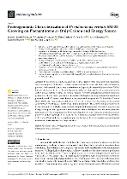Proteogenomic Characterization of Pseudomonas veronii SM-20 Growing on Phenanthrene as Only Carbon and Energy Source

Author
Firrincieli, Andrea
Chalova, Petra
Publication date
2024Published in
MicroorganismsVolume / Issue
12 (4)ISBN / ISSN
ISSN: 2076-2607ISBN / ISSN
eISSN: 2076-2607Metadata
Show full item recordCollections
This publication has a published version with DOI 10.3390/microorganisms12040753
Abstract
In this study, we conducted an extensive investigation of the biodegradation capabilities and stress response of the newly isolated strain Pseudomonas veronii SM-20 in order, to assess its potential for bioremediation of sites contaminated with polycyclic aromatic hydrocarbons (PAHs). Initially, phenotype microarray technology demonstrated the strain's proficiency in utilizing various carbon sources and its resistance to certain stressors. Genomic analysis has identified numerous genes involved in aromatic hydrocarbon metabolism. Biodegradation assay analyzed the depletion of phenanthrene (PHE) when it was added as a sole carbon and energy source. We found that P. veronii strain SM-20 degraded approximately 25% of PHE over a 30-day period, starting with an initial concentration of 600 mu g/mL, while being utilized for growth. The degradation process involved PHE oxidation to an unstable arene oxide and 9,10-phenanthrenequinone, followed by ring-cleavage. Comparative proteomics provided a comprehensive understanding of how the entire proteome responded to PHE exposure, revealing the strain's adaptation in terms of aromatic metabolism, surface properties, and defense mechanism. In conclusion, our findings shed light on the promising attributes of P. veronii SM-20 and offer valuable insights for the use of P. veronii species in environmental restoration efforts targeting PAH-impacted sites.
Keywords
Pseudomonas, biodegradation, polycyclic aromatic hydrocarbons (PAHs), phenanthrene (PHE), proteomics, genomics
Permanent link
https://hdl.handle.net/20.500.14178/2646License
Full text of this result is licensed under: Creative Commons Uveďte původ 4.0 International







